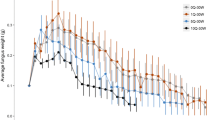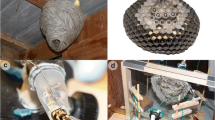Summary
Field observations and laboratory experiments demonstrate that in the Australian meat ant, Iridomyrmex purpureus, the modes of colony founding are remarkably diverse. New colonies can originate from single foundresses (haplometrosis), or foundress associations (pleometrosis), or by colony budding, or the adoption of newly-mated queens that dig founding chambers next to mature nests (probably their natal nests, as workers protect them and may help them dig). Readoption of foundresses and pleometrosis lead to the coexistence of several queens in one nest. We discovered a striking antagonistic behavior among coexisting queens in young colonies, in the form of ritualized antennation bouts. These interactions result in a reproductive rank order in which dominant queens inhibit egg-laying by subordinates, but escalation into physical fighting is rare. Workers ignore queen dominance interactions and treat all queens equally. The first quantitative ethogram of dominance display behavior between multiple ant queens, and its reproductive consequences, is presented. As a colony grows, queens become intolerant of each other's presence and permanently separate within the nest. Once separated, queens appear to be equal in status, laying approximately equal numbers of eggs. All queens continue to be tolerated by workers, even when the colony has reached a size of several thousand workers and begun to produce reproductives. Such mature nests of I. purpureus fulfill the criteria of oligogyny, defined by worker tolerance toward more than one queen and antagonism among queens, such that a limited number of fully functional queens are spaced far apart within a single colony. Oligogynous colonies can arise in this species by pleometrotic founding (primary oligogyny) or by adoption of queens into existing nests (secondary oligogyny). The adaptive significance of the complex system of colony founding, queen dominance and oligogyny in I. purpureus is discussed.
Similar content being viewed by others
References
Bartz SH, Hölldobler B (1982) Colony founding in Myrmecocystus mimicus Wheeler (Hymenoptera: Formicidae) and the evolution of foundress associations. Behav Ecol Sociobiol 10:137–147
Bhatkar A, Whitcomb WH (1970) Artificial diet for rearing various species of ants. Fla Entomol 53:229–232
Breed M (1982) Juvenile hormone and aggression in the honey bee. In: Breed MD, Michener CD, Evans HE (eds) The biology of social insects. Westview, Boulder, Col
Brothers D, Michener C (1974) Interactions in colonies of primitively social bees III. Ethometry of division of labor in Lasioglossum zephyrum (Hymenoptera: Halictidae). J Comp Physiol 90:129–168
Buschinger A (1974) Monogynie und Polygynie in Insektensozietäten. In: Schmidt GH (ed) Sozialpolymorphismus bei Insekten. Wissenschaftliche Verlagsgesellschaft, Stuttgart
Cavill GWK, Ford DL, Locksley HD (1956) The chemistry of ants I. Terpenoid constitutents of some Australian Iridomyrmex species. Aust J Chem 9:288–293
Cole BJ (1981) Dominance hierarchies in Leptothorax ants. Science 212:83–84
Duncan-Weatherly AH (1953) Some aspects of the biology of the mounds ant Iridomyrmex detectus (Smith). Aust J Zool 1:178–182
Ettershank G (1971) Some aspects of the ecology and nest microclimatology of the meat ant, Iridomyrmex purpureus (Sm.). Proc R Soc Victoria 84:137–152
Ettershank G, Ettershank JA (1982) Ritualized fighting in the meat ant Iridomyrmex purpureus (Smith) (Hymenoptera: Formicidae). J Aust Entomol Soc 21:97–102
Evesham EJM (1984) Queen distribution movements and interactions in a semi-natural nest of the ant Myrmica rubra L. Insectes Soc 31:5–19
Fletcher DJC, Blum MS (1983) Regulation of queen number by workers in colonies of social insects. Science 219:312–315
Fletcher DJC, Ross KG (1985) Regulation of reproduction in eusocial Hymenoptera. Annu Rev Entomol 30:319–344
Fowler HG, Roberts RB (1983) Anomalous social dominance among queens of Camponotus ferrugineus (Hympenoptera: Formicidae). J Nat Hist 17:185–187
Franks NR, Scovell E (1983) Dominance and reproductive success among slave-making worker ants. Nature 304:724–725
Gadagkar R (1980) Dominance hierarchy and division of labor in the social wasp, Ropalidia marginata (Lep.) (Hymenoptera: Vespidae). Curr Sci 497:72–775
Greaves T (1971) The distribution of the three forms of the meat ant Iridomyrmex purpureus (Hymenoptera: Formicidae) in Australia. J Aust Entomol Soc 10:15–21
Greaves T (1973) Biological problems in the control of the meat ant Iridomyrmex purpureus (Smith) (Hymenoptera: Formicidae). J Aust Entomol Soc 12:284–288
Greaves T, Hughes RD (1974) The population biology of the meat ant. Aust J Zool 13:329–351
Greenslade PJM (1975a) Dispersion and history of a population of the meat ant Iridomyrmex purpureus (Hymenoptera: Formicidae). Aust J Zool 23:495–510
Greenslade PJM (1975b) Short-term change in a population of the meat ant Iridomyrmex purpureus (Hymenoptera: Formicidae). Aust J Zool 23:495–510
Greenslade PJM, Halliday RB (1983) Colony dispersion and relationships of meat ants, Iridomyrmex purpureus and allies in an arid locality in South Australia. Insectes Soc 30:82–99
Halliday RB (1979) Esterase variation at three loci in meat ants. J Hered 70:57–61
Halliday RB (1983) Social organization of meat ants, Iridomyrmex purpureus, analysed by gel electrophoresis of enzymes. Insectes Soc 30:45–56
Hölldobler B (1962) Zur Frage der Oligogynie bei Camponotus ligniperda Latr. und Camponotus herculeanus L. (Hymenoptera: Formicidae). Z Angew Entomol 49:337–352
Hölldobler B, Taylor RW (1983) A behavioral study of the primitive ant Nothomyrmecia macrops Clark. Insectes Soc 30:384–401
Hölldobler B, Wilson EO (1977) The number of queens: an important trait in ant evolution. Naturwissenschaften 64:8–15
Jeanne RL (1972) Social biology of the neotropical wasp Mischocyttarus drewseni. Bull Mus Comp Zool Harv Univ 144:63–150
Mintzer A (1979) Colony foundation and pleometrosis in Camponotus (Hymenoptera: Formicidae). Pan Pac Entomol 55:81–89
Pardi L (1948) Dominance order in Polistes wasps. Physiol Zool 21:1–13
Röseler P (1965) Beobachtungen über die Verhaltensweisen in künstlich erzielten polygynen Hummelvölkern. Insectes Soc 12:105–116
Röseler P, Röseler I, Strambi A, Augier R (1984) Influence of insect hormones on the establishment of dominance hierarchies among foundresses of the paper wasp Polistes gallicus. Behav Ecol Sociobiol 15:133–142
Stumper R (1962) Sur un effect de groupe chez les femelles de Camponotus vagus (Scopoli). Insectes Soc 9:329–333
Taki A (1976) Colony founding of Messor aciculatum (Fr. Smith) (Hymenoptera: Formicidae) by single and grouped queens. Physiol Ecol Jpn 17:503–512
Torossian C (1961) Les echanges trophallactiques proctodeaux chez la fourmi d'Argentine: Iridomyrmex humilis (Hym. Form. Dolichoderinae). Insectes Soc 8:189–191
Torossian C (1979) Importance quantitative des oeufs abortifs d'ouvrieres dans le bilan trophique de la colonies de la fourmi Dolichoderus quadripunctatus. Insectes Soc 26:295–299
Traniello JFA (1982) Population structure and social organization in the primitive ant, Amblyopone pallipes (Hymenoptera: Formicidae). Psyche 89:65–80
Tschinkel WR, Howard DF (1983) Colony founding by pleometrosis in the fire ant Solenopsis invicta. Behav Ecol Sociobiol 12:103–113
Waloff N (1957) The effect of the number of queens of the ant Lasius flavus (Fab.) (Hymenoptera: Formicidae) on their survival and on the rate of development of the first brood. Insectes Soc 4:391–408
West MJ (1967) Foundress associations in polistine wasps: dominance hierarchies in the evolution of social behavior. Science 157:1584–1585
West-Eberhard MJ (1978) Temporary queens in Metapolybia wasps: Nonreproductive helpers without altruism? Science 200:441–443
Wheeler DE (1984) Behavior of the ant Procryptocerus scabriusculus (Hymenoptera: Formicidae), with comparisons to other cephalotines. Psyche 91:171–192
Wilson EO (1974) Aversive behavior and competition within colonies of the ant Leptothorax curvispinosus. Ann Entomol Soc Am 67:777–780
Wilson EO (1975) Leptothorax duloticus and the beginnings of slavery in ants. Evolution 29:108–119
Author information
Authors and Affiliations
Rights and permissions
About this article
Cite this article
Hölldobler, B., Carlin, N.F. Colony founding, queen dominance and oligogyny in the Australian meat ant Iridomyrmex purpureus . Behav Ecol Sociobiol 18, 45–58 (1985). https://doi.org/10.1007/BF00299237
Received:
Accepted:
Issue Date:
DOI: https://doi.org/10.1007/BF00299237




